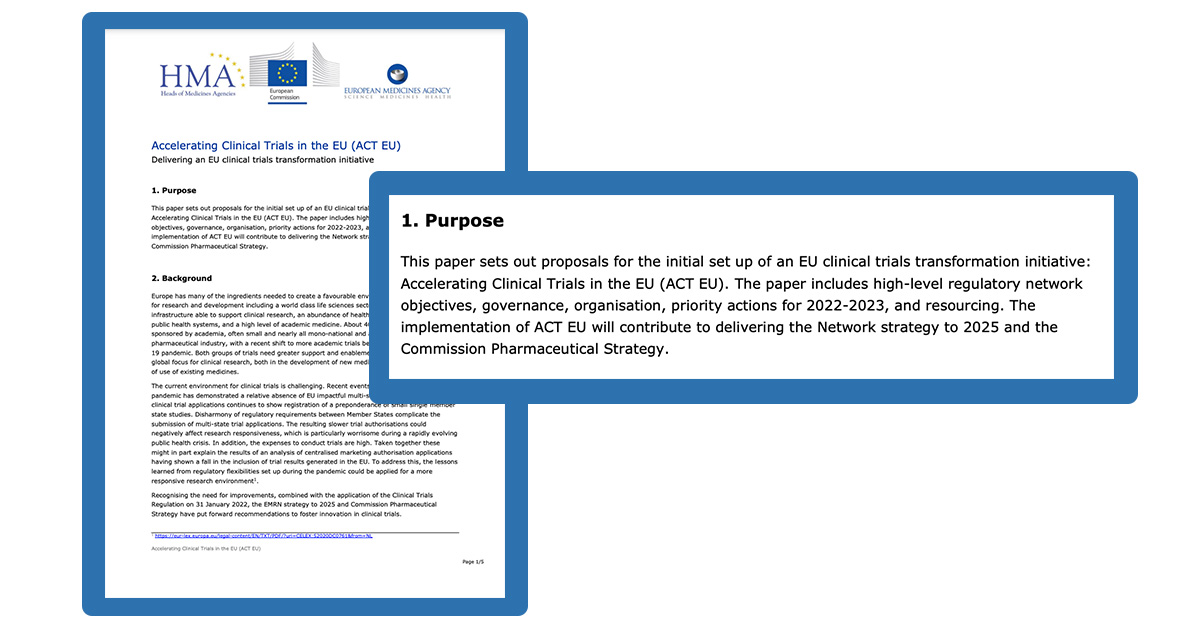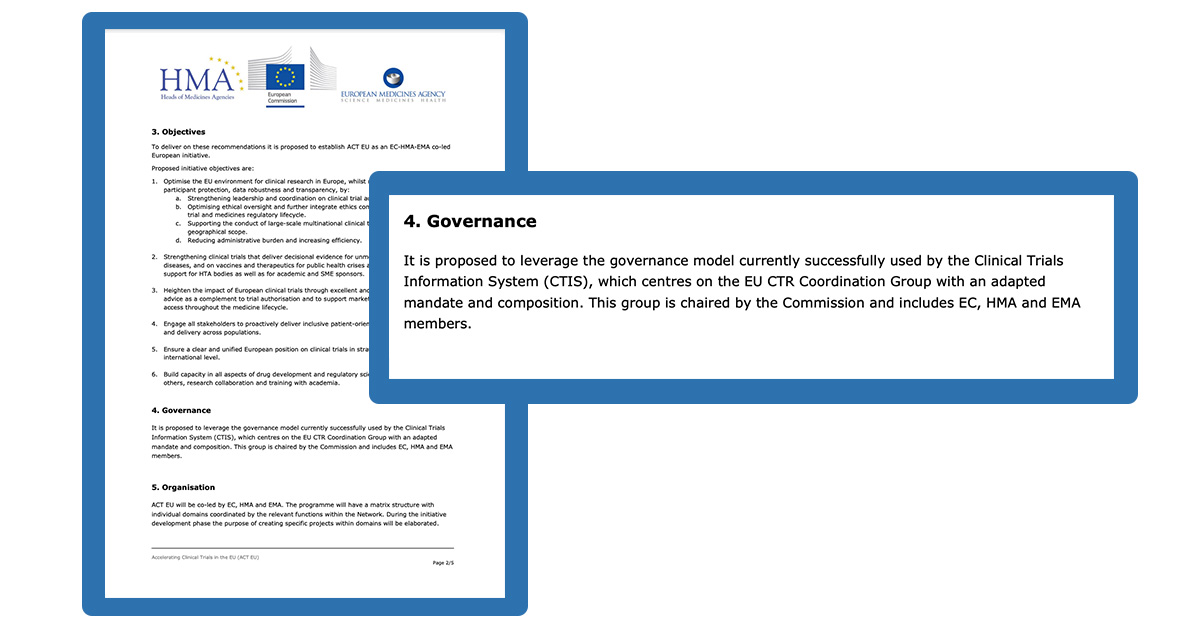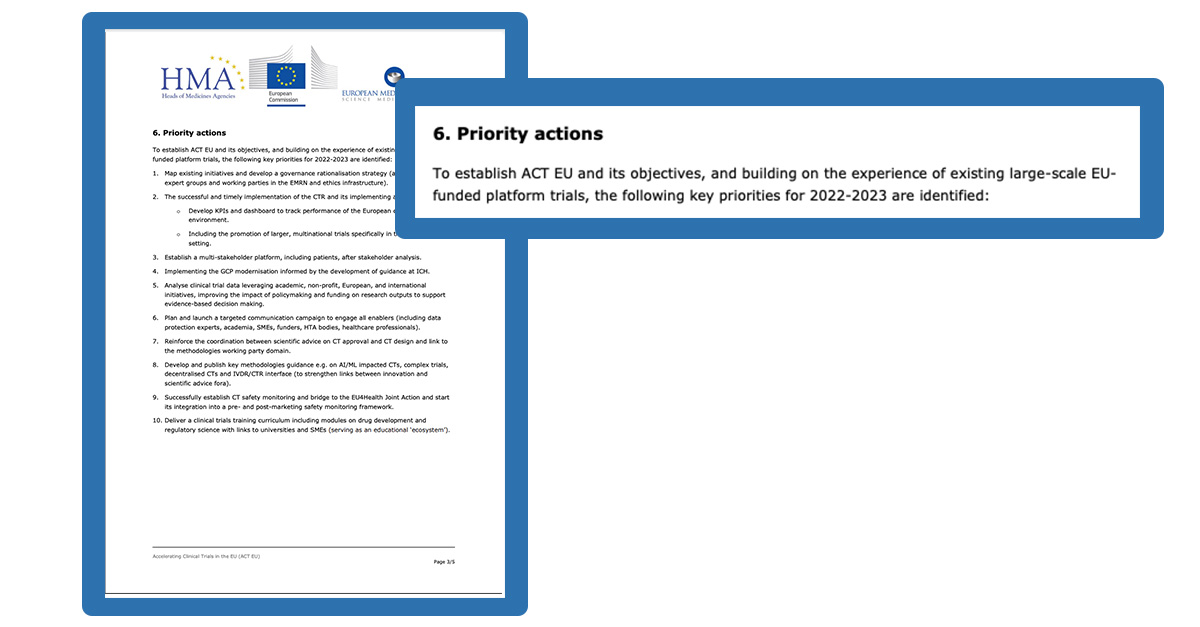How the New EU Clinical Trials Regulation Will Impact Sites and Sponsors
The Clinical Trials Regulation (CTR) for the EU took effect on 31 January 2022. Sites and sponsors must now embrace the new regulations to successfully run clinical trials across the European Union.
To help, the European Commission (EC), Heads of Medicines Agencies (HMA), and European Medicines Agency (EMA) came together to create the Accelerating Clinical Trials in the EU (ACT EU) Initiative.
This initiative consists of 10 suggested actions for sites, sponsors, and CROs to take over the next three years, leading up to the full implementation deadline in January 2025.
Here’s what we’ll cover in this article to help you get ready:
- The goals of the EU Clinical Trials Regulation
- The potential of the new Clinical Trials Information System (CTIS) database
- What challenges the new regulation and database will create
- 10 actions ACT EU suggests to prepare for the future
The information presented here is for informational purposes only and is not for implementation in operations. Please consult official documents for operational use.
The Goals of the EU Clinical Trials Regulation
The goal of the new EU Clinical Trials Regulation is to streamline the clinical trial process so Europe becomes a more competitive destination for clinical trials, without sacrificing participant safety or data accuracy.
If that sounds familiar, it’s because this movement to streamline trials is also taking place in the UK and the US.
As Bone Therapeutics CEO Miguel Forte notes, the EU falls behind the U.S., China, and Japan when it comes to hosting clinical trials. If the EU wants to compete, they’ll need to adopt new clinical trial innovations.
After the COVID-19 pandemic, clinical trial organisations realised that 100% site-based trials and in-person monitoring visits weren’t the only options available. Regulatory organisations have now started drafting guidelines that allow for:
- Remote monitoring
- Use of local sites like pharmacies and doctors’ offices
- Home visits
- At-home data collection
Remote monitoring is especially important in the EU since EU trials are often multinational, as HMA chairperson Karl Brioch points out. Having many countries cooperating on a trial can help with recruitment, especially for rare disease trials. But it won’t work unless the sponsor can easily monitor clinical trial sites in multiple countries.
The Clinical Trials Regulation is designed to enable remote monitoring and multinational trials. One way it does this is through the creation of the Clinical Trials Information System database.

The Potential of the New Clinical Trials Information System (CTIS)
The EU Clinical Trials Regulation also introduces the Clinical Trials Information System (CTIS) database.
This website, launched on 31 January 2022, serves two purposes:
- Supports communication between clinical trial sponsors and EU regulatory authorities
- Lets the public view information on EU clinical trials on a searchable website
Although sponsors can start using CTIS right away, existing regulatory authority applications will be available until January 2023. In that month, all new trials will start going through the system. Beginning in 2025, all new and ongoing trials will have to be loaded into CTIS.
CTIS comes with many advantages. Fergus Sweeney, who heads the EMA’s Clinical Studies and Manufacturing Task Force, believes the CTIS will lead to research being less divided by country. This could result in better medical treatments for participants across the EU.
The Clinical Trials Information System could also promote efficiency, since sponsors can submit a single application instead of applying to the regulatory authorities of each EU country individually.
But like all major changes, the CTIS and Clinical Trials Regulation will bring challenges as well as advantages.

What Challenges the Clinical Trials Regulation and CTIS Will Create
The two biggest challenges of implementing the CTR and CTIS will be:
- A learning curve for sponsors and regulatory agencies
- Slower activation of trial sites in the short-term
Adopting new regulations and new technology often proves difficult for organisations, even if the regulations are ultimately helpful. Change is hard.
Clinical trial sponsors can use change management techniques to make the transition to the CTIS easier. But it will still take time, especially for smaller academic sponsors that have less staff, as Miguel Forte of Bone Therapeutics points out.
Using the CTR and CTIS should speed up clinical trials in the long term by allowing sponsors to get approval from multiple countries at once. But in the short term, figuring out the new regulations could slow down the activation of clinical trial sites.
GCP CEO Marieke Meulemans notes that while EU regulatory agencies will work together to review the sponsor’s documents, each individual member state can still decide whether they want a trial to take place in their country.
This means that regulators from every country in the trial have to log into the CTIS and come to an agreement on multinational submissions. This could slow down the process until all of those countries understand the system well.
The key here is implementing training and change management strategies throughout all EU member states, not just the ones that are currently most familiar with clinical trials. We offer a free change management course that can help clinical trial teams adopt new technology. Sites and sponsors can also partner with CTIS experts to learn the specifics of the new system.

10 Actions to Prepare for the New EU Clinical Trials Regulation
So how can regulatory agencies and sponsors get ready for new EU clinical trial regulations? The ACT EU Initiative lists ten priority actions, which we’ve broken down here:
1. Align different expert groups across the European Medicines Regulatory Network and ethics infrastructure
The European Medicines Regulatory Network brings together regulatory experts from all EU member countries. For the EU Clinical Trials Regulation to be effective, these experts will need to coordinate on how to interpret the regulations and how they will enforce them when looking at sponsor applications.
2. Implement all parts of the Clinical Trials Regulation
a. Develop KPIs and dashboards to track performance of the European Clinical Trials Environment
The Clinical Trials Regulation mainly focuses on the Clinical Trials Information System, but sponsors and regulatory agencies need to ensure they understand and are implementing all parts of the Regulation. By setting Key Performance Indicators and creating dashboards, the EMA can ensure organisations are actually adopting the EU Clinical Trials Regulation.
b. Include the promotion of larger, multinational trials, specifically in the academic setting.
The Clinical Trials Regulation will make multinational trials easier, but the ACT EU initiative goes beyond just making them easier and encourages sites and sponsors to hold multinational trials. As the COVID pandemic demonstrated, multinational and community-based trials can lead to faster recruitment and better healthcare for more patients.
3. Establish a multi-stakeholder platform, including patients, after stakeholder analysis
The Clinical Trials Information System will include a public website that patients can search to receive information about clinical trials. But it’s also important that sponsors and regulatory agencies collaborate with patients when designing trials to create patient-centric trial protocols.
4. Implement the GCP modernisation informed by the development of guidance at ICH
The EU clinical trial regulations align with the Good Clinical Practice guidelines outlined by the International Council for Harmonisation. As the ICH updates GCP guidelines, EU clinical trials regulations will likely evolve accordingly.
5. Analyse clinical trial data leveraging academic, non-profit, European and international initiatives, improving the impact of policymaking and funding on research outputs to support evidence-based decision making
Sponsors, sites, and CROs have long embraced data-driven trials, and data sharing makes clinical trials more efficient. By sharing data with one another, pharmaceutical sponsors, academic medical centres, and nonprofit organisations can build on that data to plan better trials and avoid repeating each other’s work.
6. Plan and launch a targeted communication campaign to engage all enablers (including data protection experts, academia, small and medium-sized enterprises [SMEs], funders, Health Technology Assessment (HTA) bodies, healthcare professionals)
Clinical trial regulatory agencies recognize that large international sponsors aren’t the only organisations who need to understand the new regulations. Smaller nonprofit and academic organisations also need a strong grasp of the EU Clinical Trials Regulation, which is why communications from the EMA must reach all stakeholders, not only the largest ones.
7. Reinforce the coordination between scientific advice on clinical trial approval and design and link to the methodologies working party domain
This initiative focuses on ensuring that sponsors integrate scientific advice from the beginning when they’re planning clinical trials. Sponsors can then submit all of the information on trial protocol in one unified location, the Clinical Trials Information System.
8. Develop and publish key methodologies guidance eg, on artificial intelligence (AI)/machine learning (ML) impacted clinical trials, complex trials, decentralised clinical trials and In Vitro Diagnostic Medical Devices Regulation (IVDR)/CTR interface (to strengthen links between innovation and scientific advice fora)
With this proposal, the ACT EU working group recognizes that clinical trials are becoming more complex. In the long term, the European Commission (EC), Heads of Medicines Agencies (HMA), and European Medicines Agency (EMA) will need to come together to create regulations for decentralised clinical trials, the use of AI, and other innovative trial methods.
9. Successfully establish clinical trial safety monitoring and bridge to the EU4Health Joint Action and start its integration into a pre- and post-marketing safety monitoring framework
The clinical trial industry keeps moving toward flexible, tech-enabled remote monitoring. The goal now is to ensure that safe and effective monitoring is a reality throughout all phases of clinical trials and all member states in the EU.
10. Deliver a clinical trials training curriculum including modules on drug development and regulatory science with links to universities and SMEs (serving as an educational ‘ecosystem’)
Clinical trials often have trouble recruiting for entry-level positions, such as junior Clinical Research Associates (CRAs). By expanding knowledge about clinical trials through educational resources, clinical trial organisations can prepare more entry-level workers or job-changers for careers in clinical research.
Prepare for the EU Clinical Trials Regulation
The EU Clinical Trials Regulation will bring greater visibility and international synchronisation to research studies in the EU. With the Clinical Trials Information System, the general public can see ongoing and completed trials. Sponsors can also submit a single application for regulatory approval across any EU member state.
Ultimately, the EU hopes to move toward more streamlined, multinational, and tech-based clinical trials. This matches the goals of other countries around the world and could lead to the EU becoming a highly competitive location for clinical studies.
To learn more about how international clinical trial regulations impact clinical trials and clinical trial technology, check out our data protection and compliance resources.

